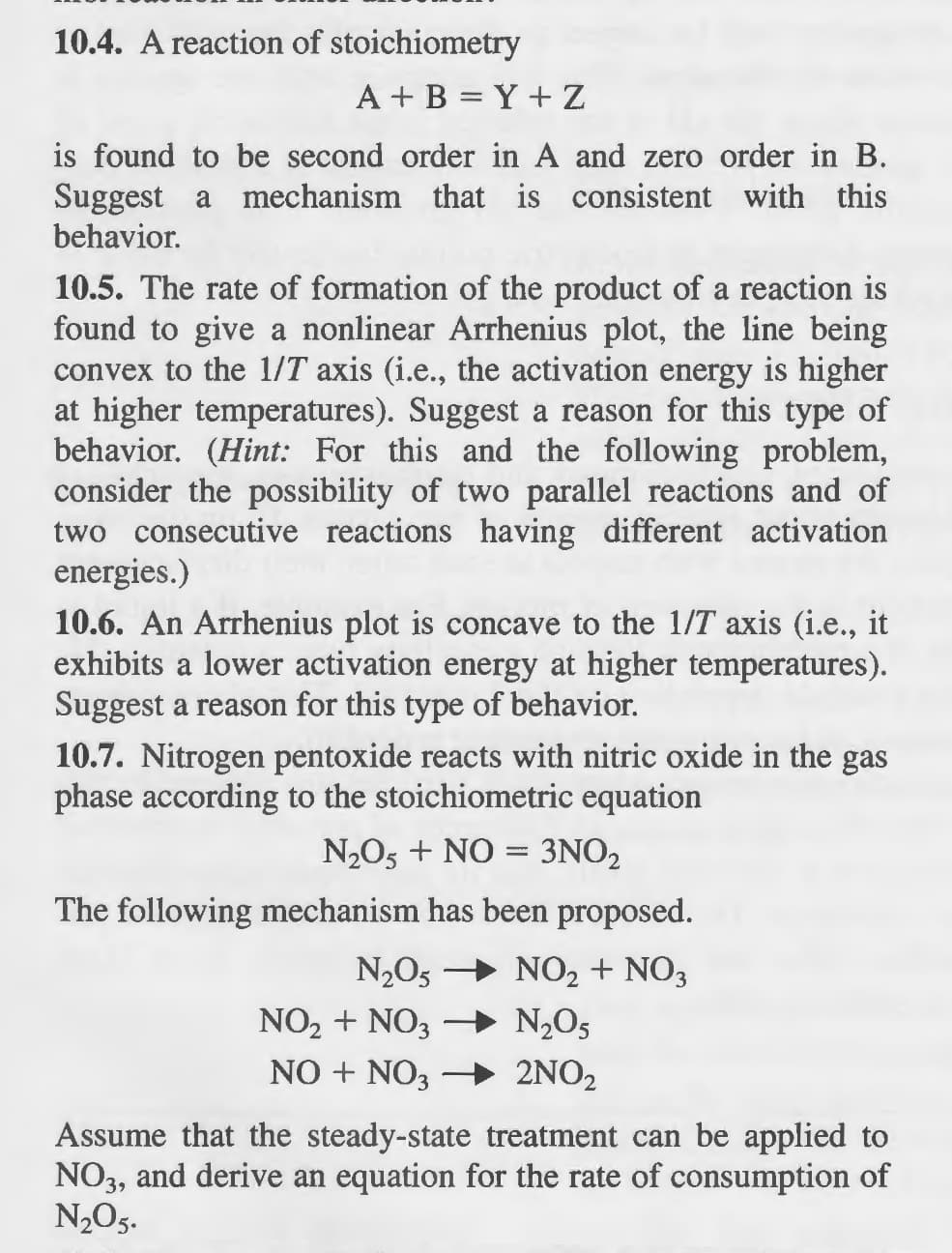10.4. A reaction of stoichiometry A+B=Y+Z is found to be second order in A and zero order in B. Suggest a mechanism that is consistent with this behavior.
10.4. A reaction of stoichiometry A+B=Y+Z is found to be second order in A and zero order in B. Suggest a mechanism that is consistent with this behavior.
Chemistry for Engineering Students
4th Edition
ISBN:9781337398909
Author:Lawrence S. Brown, Tom Holme
Publisher:Lawrence S. Brown, Tom Holme
Chapter11: Chemical Kinetics
Section: Chapter Questions
Problem 11.49PAE: The rate of photodecomposition of the herbicide piclo- ram in aqueous systems was determined by...
Related questions
Question
solve question 4

Transcribed Image Text:10.4. A reaction of stoichiometry
A+B=Y + Z
is found to be second order in A and zero order in B.
Suggest a mechanism that is consistent with this
behavior.
10.5. The rate of formation of the product of a reaction is
found to give a nonlinear Arrhenius plot, the line being
convex to the 1/T axis (i.e., the activation energy is higher
at higher temperatures). Suggest a reason for this type of
behavior. (Hint: For this and the following problem,
consider the possibility of two parallel reactions and of
two consecutive reactions having different activation
energies.)
10.6. An Arrhenius plot is concave to the 1/T axis (i.e., it
exhibits a lower activation energy at higher temperatures).
Suggest a reason for this type of behavior.
10.7. Nitrogen pentoxide reacts with nitric oxide in the gas
phase according to the stoichiometric equation
N₂O5 + NO = 3NO₂
The following mechanism has been proposed.
N₂O5NO₂ + NO3
NO₂ + NO3
N₂O5
NO + NO3 → 2NO₂
Assume that the steady-state treatment can be applied to
NO3, and derive an equation for the rate of consumption of
N₂O5.
Expert Solution
This question has been solved!
Explore an expertly crafted, step-by-step solution for a thorough understanding of key concepts.
Step by step
Solved in 2 steps with 1 images

Knowledge Booster
Learn more about
Need a deep-dive on the concept behind this application? Look no further. Learn more about this topic, chemistry and related others by exploring similar questions and additional content below.Recommended textbooks for you

Chemistry for Engineering Students
Chemistry
ISBN:
9781337398909
Author:
Lawrence S. Brown, Tom Holme
Publisher:
Cengage Learning

Chemistry: The Molecular Science
Chemistry
ISBN:
9781285199047
Author:
John W. Moore, Conrad L. Stanitski
Publisher:
Cengage Learning

Principles of Modern Chemistry
Chemistry
ISBN:
9781305079113
Author:
David W. Oxtoby, H. Pat Gillis, Laurie J. Butler
Publisher:
Cengage Learning

Chemistry for Engineering Students
Chemistry
ISBN:
9781337398909
Author:
Lawrence S. Brown, Tom Holme
Publisher:
Cengage Learning

Chemistry: The Molecular Science
Chemistry
ISBN:
9781285199047
Author:
John W. Moore, Conrad L. Stanitski
Publisher:
Cengage Learning

Principles of Modern Chemistry
Chemistry
ISBN:
9781305079113
Author:
David W. Oxtoby, H. Pat Gillis, Laurie J. Butler
Publisher:
Cengage Learning
